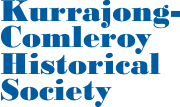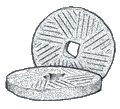
ABOUT the KURRAJONG-COMLEROY HISTORICAL SOCIETY
WHO AND WHERE WE ARE
The Kurrajong-Comleroy Historical Society was formed on Sunday 28 January 2001. It is dedicated to researching, recording, preserving and promoting the heritage of the district northwest of the Hawkesbury River in the Hawkesbury Local Government Area, New South Wales, Australia.
During the early 1800s this district was referred to as “the currijon”, “the Kurryjung Brush”, the “Kurrajong Brush”, or simply as “The Kurrajong”. It comprised an area on the north-western side of the Hawkesbury River which today includes the townships and villages of Kurrajong, Kurrajong Heights, Kurrajong Hills, East Kurrajong, Blaxlands Ridge, Colo Heights, Bilpin, Bowen Mountain, Grose Vale, Grose Wold, North Richmond, Kurmond, The Slopes, Tennyson, Glossodia, and Wilberforce.

Map showing "The Kurrajong" (shaded grey) and its towns of today. [Map by Greg Upton].
FORMATION OF THE KURRAJONG-COMLEROY HISTORICAL SOCIETY
The Society was formed on Sunday 28th January 2001 at a meeting of
approximately 50 people who had the common aim to raise awareness of the
historical heritage of "the Kurrajong", and to ensure that this history
be preserved for future generations.
The Society became affiliated with the Royal Australian Historical
Society in June 2001 and formally incorporated as an association a few
months afterwards. It became affiliated with the Blue Mountains
Association of Cultural Heritage Organisations in 2008.
The Society’s official logo (designed by the late Tony Dixon) is based on Ben Singleton’s millstones which date from at least 1816 and are considered to be one of the oldest items of European heritage remaining in the Kurrajong district today. The mill is believed to have operated on Little Wheeny Creek near the present Old Bells Line of Road bridge (see The Millstone May/June 2002. ) The very first issue of The Millstone notes that the millstones were selected as the logo as they symbolise how the Kurrajong district's history has been treated: “... dumped in the creek (1860), retrieved and used as a war memorial (1920), discarded during road widening (1945), rescued (1958), forgotten, rescued again (1988) ...”.
You can find out more about our area on the Kurrajong Website . Come and pay us a visit!